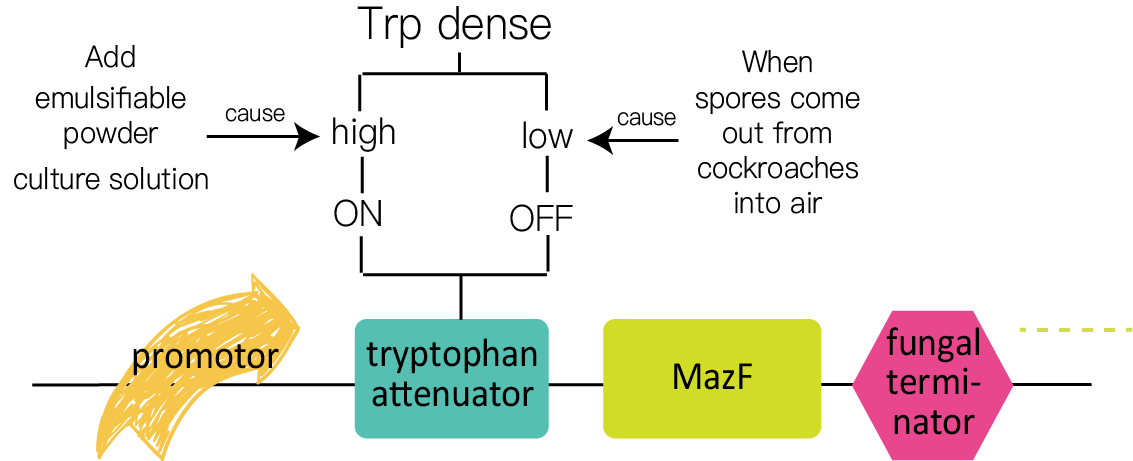
Design
Background
As the background we described, to solve the problem that cockroaches’ flooding in home environment, we use the transformant of Metarhizium anisopliae to achieve the effect of killing the cockroaches. In order to ensure the lethal effect of Metarhizium anisopliae , we improved in three ways: adhesion, penetration, and immune-avoidance.
Which chassis to choose and why?
The biological chassis we chose was Metarhizium anisopliae. This is an entomogenous fungus that infects more than 200 species of insects, most of which are pests includes cockroaches[1]. Its infection process is divided into the following steps: spore attachment -- penetration through the body wall -- colonization in vivo -- killing the host -- re-sporulation. It is a natural insecticide, and by genetically-enhancing it, we can make better use of it.

How to achieve?
We designed a system to improve Metarhizium anisopliae from three aspects: HsbA, Bbchit and MCL1.
HsbA: The HsbA from Beauveria bassiana encodes a kind of membrane surface hydrophobic protein which helps spores adhere to the waxy surface of cockroaches[2]. Then it will be followed as spores' germination, germinal tube, appressorium, and next is penetration.
Bbchit: Cockroaches’ body wall is composed of protein, chitin, and lipids. Bbchit ,which comes from Beauveria bassiana,encodes chinase[3]. It can decompose chitin to penetrate. Thereby,fungus can enter into hemolymph.
MCL1: Cockroaches have powerful immune system. If there is no effective response, our chassis won't be recognized and killed by host hemocytes. The MCL1 gene from Metarhizium Robertsii can encode collagen-like protein, which binds and masks β-1,3-glucan (an antigen that can be recognized by hemocytes), thus Metarhizium anisopliae can escape the immune response of cockroaches[4].
How to ensure safety?
We designed a suicide switch for our system. It consists of tryptophan attenuator and MazF.Tryptophan attenuator will be switched on in high trp concentration,while it will be switched off on the contrary . MazF is a kind of toxic protein。 To make it expressed in our chassis,we added a Kozak sequence (In eukaryotic cells, efficient transcription initiation is dependent on a sequence called kozak surrounding the initiation codon ATG. Equivalent to the SD sequence in prokaryotes.)in front of these two parts. We create a high Tryptophan concentration environment while we are culturing the fungus, and average concentration of Trp inside cockroach hemolymph is about 0.15%[5]. In those environment, the Tryptophan attenuator forms a hairpin structure that stop transcription ahead of MazF, so that fungus can keep alive. If the fungus live in the low tryptophan environment , the suicide switch will be turned on and the MazF starts to express,which leads to death of fungus.

References
[1] Wang C, Lü Dingding, Li Lin. Study on pathogenicity and degradation mechanism of entomogenous fungi [C]// Chinese Society of Fungal Sciences Academic Symposium. 2008.
[2] Ye Zhang, Zhongren Lei, Haihong Wang, Jiqing Zhan. Prokaryotic expression and immunolocalization Beauveria bassiana HsbA protein [J] Chinese Agricultural Sciences, 2013,46 (21): 4534-4541.
[3] Liu Zhihui, Chen Shouwen, Guo Zhihong, et al. Correlation between extracellular protease and chitinase activity of Beauveria bassiana and virulence to Asian corn borer[J]. Journal of Huazhong Agricultural University, 2005, 24(4) :364-368.
[4] Wang C, St Leger R J. A collagenous protective coat enables Metarhizium anisopliae to evade insect immune responses.[J]. Proceedings of the National Academy of Sciences of the United States of America, 2006, 103(17):6647-6652.
[5] Sowa S M, Keeley L L. Free amino acids in the hemolymph of the cockroach, Blaberus discoidalis[J]. Comparative Biochemistry & Physiology Part A Physiology, 1996, 113(2):131.

